Mahane Yehuda Market
Mahane Yehuda Market (Hebrew: שוק מחנה יהודה, Shuk Mahane Yehuda), often referred to as "The Shuk" (Hebrew: השוק, HaShuq),[1] is a marketplace (originally open-air, but now partially covered) in Jerusalem. Popular with locals and tourists alike, the market's more than 250 vendors[2] sell fresh fruits and vegetables; baked goods; fish, meat and cheeses; nuts, seeds, and spices; wines and liquors; clothing and shoes; and housewares, textiles, and Judaica.[3][4]
| Mahane Yehuda Market | |
|---|---|
Shuk Mahane Yehuda | |
_(45298221191).jpg.webp) Mahane Yehuda Market on a busy Friday | |
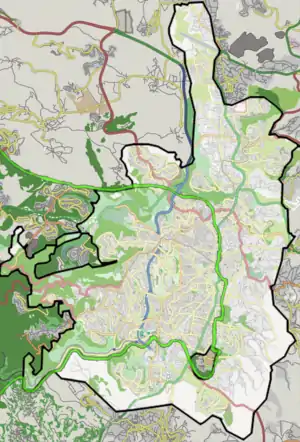 Location within Jerusalem | |
| Alternative names | The Shuk or Machne |
| General information | |
| Location | Jerusalem |
| Coordinates | 31°47′08″N 35°12′44″E |
| Opened | Late 19th century |
| Management | Machane Yehuda Management |
In and around the market are falafel, shawarma, kibbeh, kebab, shashlik, kanafeh, baklava, halva, zalabiya and Jerusalem mixed grill stands, juice bars, cafes, and restaurants.[2] The color and bustle of the marketplace is accentuated by vendors who call out their prices to passersby.[2] On Thursdays and Fridays, the marketplace is filled with shoppers stocking up for Shabbat,[5] until the Friday afternoon sounding of the bugle that signifies the market will close for the Sabbath.[2][6] In recent years, the 'shuk' has emerged as another Jerusalemic nightlife center, with restaurants, bars and live music.[7]
Geography
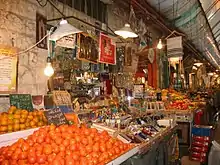
Mahane Yehuda market is bounded by Jaffa Road to the north, Agrippas Street to the south, Beit Yaakov Street to the west, and Kiach Street to the east.[8] The market itself has two major streets: Eitz Chaim Street (the covered market) and Mahane Yehuda Street (the open-air market). Bisecting these two streets are smaller streets that all used to be named for fruits and nuts—Afarsek (Peach) Street, Agas (Pear) Street, Egoz (Walnut) Street, Shaked (Almond) Street, Shezif (Plum) Street, Tapuach (Apple) Street, and Tut (Berry) Street[4]—until the municipality changed the name of Agas St. to Yaakov Eliyahu Banai St.[9]
History
In 1887 the neighborhood of Mahane Yehuda was established on the north side of Jaffa Road. It was founded by three business partners—Johannes Frutiger (a German Protestant and owner of the largest bank in Palestine), Shalom Konstrum, and Joseph Navon—and was named after Navon's brother, Yehuda.[4] On the south side of the street to the west stood another neighborhood, Beit Ya'akov, founded in 1885.[10]
At the end of the 19th century, a marketplace was established on an empty lot to the east of Beit Ya'akov and across the road from Mahane Yehuda which was owned by the Sephardi Valero family;[4] this market was known as Shuk Beit Yaakov (Beit Yaakov Market).[10] Here Arab merchants and fellaheen sold their goods to the residents who lived outside the Old City. As the new neighborhoods outside the Old City grew, the Beit Yaakov Market grew apace with more stalls, tents and pavilions.[10]
Under Ottoman rule, the market expanded haphazardly and sanitary conditions worsened. In the late 1920s, the British Mandate authorities cleared out all the merchants and built permanent stalls and roofing.[4] Afterwards the market began to be known as the Mahane Yehuda Market, after the larger neighborhood.[11]
In 1931 a new section was built to the west of the market by 20 traders, who previously had only temporary wooden stalls in the area. It was later named the Iraqi Market, as many traders of Iraqi Jewish descent acquired shops there.[12] Today the Iraqi Market is located off Mahane Yehuda Street.
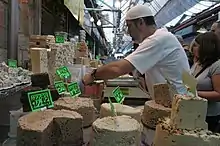
In the 2000s, major renovations were made to the Mahane Yehuda Market, including infrastructure work, repaving roads and covering some open areas.[4] The market's Board of Directors worked to make at least some of these changes in response to a decrease in visitors after terrorist attacks in 1997 and 2002 killed 23 people.[13] Changes driven by the Board included renovations to the streets and alleyways, but also included efforts to draw in cafes and boutiques that would entice more middle-class customers who might become frequent shoppers.[13] According to Eli Mizrachi, chairman of the Mahane Yehuda Merchants Association, whereas shoppers used to come to buy produce, the "new generation" wants a place with entertainment, a place to sit and have a cup of coffee, and a place to shop for gifts.[14]
In the mid-2000s, Ethiopian food sellers began to appear in and around the market.[15][16] In addition, a number of "trendy shops and cafés" began appearing among the market's retail stalls."[17] New "non-Middle Eastern" restaurants include eateries such as "Pasta Basta," specializing in Italian pasta dishes,[18] "Fish and Chips," described by one guide book as "the only fish and chips bar in Jerusalem,"[14][19] and "Ha'Agas 1," a vegetarian restaurant.[20] Other recent additions to the market's stalls include an espresso bar, "hip jewelry" stores, and designer clothing "boutiques".[3][21][22][23] Three new designer clothing stores opened in 2007 alone.[24]
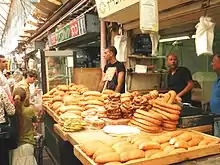
Changes in the market have transformed the area into a "night spot," with bars featuring specialty drinks, live music, and singers.[14] The change has been so pronounced that a Jerusalem Post article listed one shuk restaurant as one of the five highest-rated restaurants in the city for romantic dates.[25] The shuk also now hosts special events like the "Balabasta" dance and music festival, launched in 2010, which attracts large crowds that remain until late at night, in areas that used to be deserted.[14] The annual festival includes street performances, artwork, puppet shows, and events linked to the market's foods, such as chili-eating contests and produce-carving workshops.[26][27]
While some supporters of changes to the market claim that the revitalized shuk has actually helped to revitalize the whole city,[14][28] others are less enthusiastic about the changes, noting that real estate prices have quadrupled since the 2000s, forcing out many older shops (like vegetable and fish shops) that were staples of the market.[14] They fear that the arrival of chain stores is "part of a global phenomenon that may erase local culture".[29]
Tourism
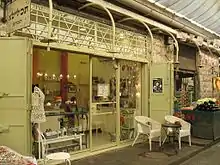
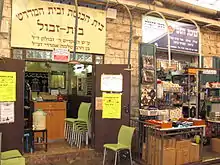
The Jerusalem Municipality has invested millions in modernizing the center of Jerusalem and creating many pedestrian malls in order to elevate commerce, tourism, and culture.[30] Nir Barkat, mayor of Jerusalem, said, "We realized if we wanted to increase our market share of tourism and the time people spend in Jerusalem, nightlife is key". In recent years, as part of this strategy, many bars and restaurants have opened in the alleyways of the Mahane Yehuda market to draw young and sophisticated customers.[7][31] Free Wi-Fi internet access is now available to customers in some of the market's shops.[32][33]
A self-guided tour of the market called "Shuk Bites" includes a map with a pre-planned route through the market and "punch-card" vouchers that allow visitors to sample a variety of foods and drinks.[34][35]
Guided shopping and cooking tours are aimed at attracting a "new breed of culinary tourists."[36]
Artwork
In 2011 the city-sponsored project "Tabula Rasa" (Blank Slate) supported urban artwork decorating walls, concrete surfaces, and even the trash bins of the market.[17] Street artist Itamar Paloge, curator for the project, recruited some 30 other artists from schools of art and photography in the city, including Bezalel, Hadassah, and Musrara, in addition to local sculptors, painters, photographers, and various artists, including street artists.[17] Jerusalem mayor Nir Barkat noted that the project is a joint venture between the merchants, the Student Union, and the municipality. Barkat stressed that Mahane Yehuda has become more than a market: it is an important part of the city's public space – and it's a unique part because of the way Jews and Arabs bargain shop side-by-side in its crowded alleyways and streets.[17]
Beginning in January 2015 the metal shutters and doors of the shops became an after-hours attraction as they were spray painted by street artist Solomon Souza.[37][38] Souza's partner in the project, Berel Hahn, arranged permission from the shopkeepers.[37][39] As of July 2016, Souza had spray-painted more than 150 of the 360 shutters in the market.[37][39]
 Metal doors with image of Golda Meir
Metal doors with image of Golda Meir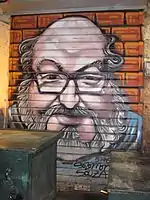
 (L. to r.) Rabbi Shlomo ben David Lakein, Naomi Shemer, and a local storeowner
(L. to r.) Rabbi Shlomo ben David Lakein, Naomi Shemer, and a local storeowner Upside-down portrait of David Ben-Gurion
Upside-down portrait of David Ben-Gurion Local storeowners
Local storeowners Arab portrait
Arab portrait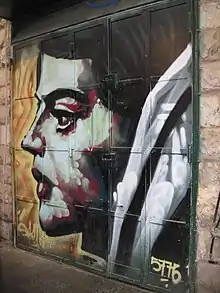
Management
Machane Yehuda Management, which includes representatives from a variety of merchants, oversees the market's business development, in dialogue with Jerusalem's city hall, Ministry of Health, and other government entities.[1] The market's new internet website was an initiative of three firms linked to Jerusalem entertainment and tourism: GoJerusalem.com, More Tourism & Gastronomy, and Action Packed Media.[40]
Clientele
The market's mixture of shops and restaurants, which includes both kosher and halal establishments, attract residents and tourists, Israelis from Jerusalem and other parts of the country, rich and poor, young and old, religious and secular, Jews and non-Jews, including members of the Arab community.[3][14][28][41] An estimated 200,000 people visit the shuk weekly.[14] With the tensions that are often pronounced among different ethnic, religious, and social groups, the shuk has been called "a national treasure."[14]
Hours of operation
Although some restaurants and cafes within Mahane Yehuda remain open on Shabbat and late into the night, food vendors normally follow a Sunday through Thursday schedule 8:00 am–7:00 pm, and a Friday schedule 8:00 am to approximately 3:00 pm.[6] Sites with entertainment that do remain open late at night normally must adhere to the city's ban on loud music after 11:00 pm, with the exception of Israel Independence Day and Purim, the two days of the year when the ban is lifted.[42]
Transportation
Several bus lines serve the market at the Agrippas end and Jerusalem Light Rail, has a Mahane Yehuda station on Jaffa Road, across from the market.[43][44] The new light rail stop has been linked both to the revival of the market and to plans for changes in the area surrounding it.[28][45]
Notable residents and businesses
Above a vegetable store
The building is empty now
The walls bare and worn
Yet immersed and sway
Reminiscent of holidays,
Of scented jasmine
Of an old tune that rings
Summoning to a feast
From 1 HaAgas Street
by Ehud Banai[21]
The first generation of the Banai family of actors and musicians originally lived at 1 HaAgas Street at the southern end of the market. In 2000 the Jerusalem municipality renamed this street as Eliyahu Yaakov Banai Street after the family's patriarch. (#1 HaAgas Street has been renumbered as #13 Eliyahu Yaakov Banai Street.[21]) Ehud Banai, a family member, wrote a song entitled "1 HaAgas Street", which describes the life and atmosphere at the family home.[46]
In 1976 Rami Levy opened his first store on Hashikma Street, one of the streets in the Mahane Yehuda district, selling food products to consumers at wholesale prices. Today Rami Levy Hashikma Marketing (TASE:RMLI) is the third largest food retailer in Israel.[47]
Holiday markets

Before Rosh Hashana, the New Year, thousands of shoppers shop in the market for foods based on different holiday traditions: everything from pomegranates, dates, and assorted honey to fish heads.[48] In the days between Rosh Hashana and Yom Kippur, a shuk kapparot (kapparot market) opens beside the Mahane Yehuda Market, where patrons perform the custom of swinging a live chicken over their heads, symbolically transferring their sins to the chicken, which is then slaughtered and donated to the poor. During the days before the holiday of Sukkot, a large tent opposite the Market, in Valero Square, hosts a shuk arba minim (Four Species market), where vendors sell lulavs, etrogs, and other ritual items used on this holiday.[49][50] For other holidays with traditional foods, such as sufganiyot for Hanukka or hamentashen for Purim, the market offers many selections,[51] sometimes with Purim hamentashen sold by vendors wearing holiday costumes.[52] In advance of the Jewish holiday of Tu Bishvat, the Jewish "New Year for Trees," the market includes special displays of seeds, nuts, and dried fruits at discounted prices.[1]
Terrorist attacks
There have been no terrorist attacks on the market in recent years. Mahana Yehuda is heavily guarded because it was a target for terrorist attacks during the Second Intifada:
- 1997 Mahane Yehuda Market Bombings: On July 30, 1997, 16 people were killed and 178 wounded in two consecutive suicide bombings.[53]
- On November 6, 1998, two terrorists died when their bombs exploded prematurely.[54]
- 2002 Mahane Yehuda Market bombing: On April 12, 2002, a female suicide bomber detonated at the entrance to the market, killing 6 and injuring 104. The Al-Aqsa Martyrs' Brigades claimed responsibility.[55]
References
- "Mahane Yehuda website". Retrieved September 6, 2012.
- Rosenthal, Morris (May 2009). "Mahane Yehuda – The Jerusalem Shuk (Outdoor Market)". Foner Books.com. Retrieved June 17, 2010.
- Mitnick, Joshua (February 27, 2008). "Whole Lotta Shuk-ing Going On". The Jewish Week. Archived from the original on October 21, 2012. Retrieved July 3, 2011.
- Browns, Shmuel (September 17, 2009). "Visiting the Mahane Yehuda Open Air Market". israelnationalnews.com. Retrieved June 17, 2010.
- "Mahane Yehuda". The Jewish Agency for Israel. Archived from the original on December 22, 2009. Retrieved June 17, 2010.
- "FAQs". Mahane Yehuda. Retrieved September 7, 2012.
- "Night Owls: Jerusalem After Dark". TimeOut. 31 May 2014.
- "Map of Mahane Yehuda Market". Israel Tour Guide.
- Hasson, Nir (December 23, 2011). "Jerusalem residents fight city to keep street names of old". Haaretz. Retrieved September 6, 2012.
- Rossoff, Dovid (1998). Where Heaven Touches Earth. Guardian Press. ISBN 0-87306-879-3.
- Wager, Eliyahu (1988). Illustrated Guide to Jerusalem. The Jerusalem Publishing House. p. 218.
- Yonah, Yaffa (Nov 3, 2009), "All Shuk Up: Returning to the Marketplace", PresenTense, archived from the original on 2011-07-27
- Steinberg, Jessica (August 10, 2012). "Savvy entrepreneurs introduce a DIY guide to Jerusalem's vibrant Mahane Yehuda". The Jerusalem Report. Retrieved September 6, 2012.
- Gradstein, Linda (July 2, 2002). "Market Makeover". The Jerusalem Report.
- Kraft, Dina (February 26, 2006). "Veteran Ethiopian Israeli community divided on Falash Mura's immigration". Jewish Agency for Israel. Archived from the original on August 7, 2011. Retrieved July 7, 2010.
- "Ethiopian Spice Shop". ethiopianrestaurant.com. 2006. Archived from the original on December 16, 2009. Retrieved July 7, 2010.
- "Urban art spices up Jerusalem's famous Mahane Yehuda market". Israel 21c.org. October 30, 2011. Retrieved September 4, 2012.
- Minsky, Loren (February 2, 2012). "Top 5 Winter Warmers in Jerusalem". The Jerusalem Post. Retrieved September 5, 2012.
- "Fish and Chips," "NileGuide: for travelers by locals," retrieved September 5, 2012
- "'Ha'Agas 1,' Vegetarian kosher restaurant". HappyCow.net. Retrieved September 5, 2012.
- "Shuk Mahane Yehuda – The New Trend in Jerusalem". www.tiuli.com. Retrieved September 4, 2012.
- Palti, Michael (October 12, 2005). "Shazif Invades the Shuk: Among the vegetable and meat stalls of Jerusalem's open-air market are a relatively new Italian coffee house, gourmet delicatessen and bistro. Is Mahane Yehuda on its way to becoming a yuppie stronghold?". Haaretz. Retrieved July 3, 2011.
- Elliman, Wendy (May 25, 2007). "From Cheap to Chic – Jerusalem shuk goes upscale". Israel Press Service. Retrieved June 17, 2010.
- Wiessen, Laura (February 22, 2007). "Designs on the Shuk". The Jerusalem Post. Retrieved June 17, 2010.
- Minsky, Loren (February 2, 2012). "Top 5 Jerusalem Date Hotspots". The Jerusalem Post. Retrieved September 9, 2012.
- "Balabasta festival 2012 in shuk Mahane Yehuda". Go Jerusalem. Retrieved September 6, 2012.
- "CITYbites: Night festivals in Mahane Yehuda market". The Jerusalem Post. July 13, 2011. Retrieved September 6, 2012.
- O'Sullivan, Arieh (July 13, 2011). "Open air market at heart of Jerusalem's revival". The Jerusalem Post. Retrieved September 6, 2012.
- Frosh, Tahel (July 28, 2008). "Aroma versus Mahane Yehuda Market". Haaretz. Retrieved September 6, 2012.
- "Jerusalem's Heart is Beating Again". TimeOut.
- "Jerusalem emerges as the capital of culture".
- "CITYbites: Sweet things all around". The Jerusalem Post. July 6, 2011. Retrieved September 6, 2012.
- "Jerusalem Shuk TWEETup". Jewlicious.com. October 15, 2009. Retrieved September 6, 2012.
- "Take yourself on a tour of Jerusalem's famed Mahane Yehuda Market". Haaretz. February 28, 2012. Retrieved September 5, 2012.
- Eglash, Ruth (May 15, 2012). "Mapping the shuk". The Jewish Week. Retrieved September 6, 2012.
- Leichman, Abigail Klein (April 8, 2012). "Gourmands discover Jerusalem's market". Israel21c.org. Archived from the original on May 12, 2012. Retrieved September 9, 2012.
- Ghert-Zand, Renee; Tress, Luke (29 February 2016). "Young artist turns Jerusalem's market into gallery of famous faces". Times of Israel. Retrieved 28 February 2017.
- Levi, Sarah (2 December 2015). "The Artist's Temple". Jerusalem Post. Retrieved 22 February 2016.
- Kalra, Vandana (16 July 2016). "A Market for Faces". The Indian Express. Retrieved 28 February 2017.
- "About". Mahane Yehuda. Retrieved September 7, 2012.
- Livneh, Nen. "Feeling they are 'losing' Jerusalem, Orthodox and secular Jewish residents join forces". Haaretz. Retrieved September 6, 2012.
- "Events". Mahane Yehuda. Retrieved September 6, 2012.
- Rosenberg, Oz (August 19, 2011). "Jerusalem's light rail system opens to the public after years of delays". Haaretz. Retrieved September 7, 2012.
- Jeffay, Nathan (October 14, 2011). "Jerusalem rail brings city closer together". The Forward. Retrieved September 7, 2012.
- Blum, Brian (May 7, 2011). "A revitalized downtown Jerusalem – with skyscrapters". Archived from the original on May 12, 2012. Retrieved September 7, 2012.
- "History of the Banai Family on 1 HaAgas Street.", Jerusalem municipality, retrieved November 8, 2009
- "Company description". The Financial Times Ltd. 2011. Retrieved June 28, 2011.
- Minsky, Loren, "Feeling the holiday spirit at Mahane Yehudah," The Jerusalem Post, September 28, 2011, retrieved September 6, 2012
- "A conversation with Shimon Vaknin, four species vendor". jerusalemite.net. 12 October 2008. Retrieved 5 February 2012.
- "Shuk Arba Minim 2011: 19 September, 2010 – 22 September, 2010". Go Jerusalem. Retrieved 5 February 2012.
- "Time to make the sufganiyot in Jerusalem". Go Jerusalem. Retrieved September 5, 2012.
- "Temple Beth El Bulletin, Fall River, Massachusetts," (PDF). February 2009. (featuring photo [page 1] of two Mahane Yehuda vendors wearing costumes while they sell hamentashen)
- "Terrorist Attacks in Israel, 1994–2006". The Israel Project. May 2, 2006. Archived from the original on October 12, 2007. Retrieved 2010-06-17.
- "Victims List – Terrorist Attacks Against Israel". israelsmessiah.com. Retrieved 2010-06-17.
- "Chronology of Palestinian Suicide Bombings". Facts of Israel.com. Archived from the original on May 29, 2010. Retrieved June 17, 2010.
External links
| Wikimedia Commons has media related to Mahane Yehuda Market. |
